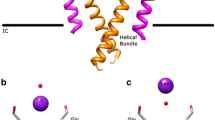Abstract
We found a new type of Ca2+-dependent K+ channel in smooth muscle cell membranes of single cells of the rabbit portal vein. A slope conductance of the current was 180 pS when 142 mM K+ solution was exposed to both sides of the membrane (this channel was named the KM channel, in comparison to the known KL and KS channels from the same membrane patch; Inoue et al. 1985). This KM channel was less sensitive to the cytoplasmic Ca2+ concentration, [Ca2+]i, but was sensitive to the extracellular Ca2+, [Ca2+]o, e.g. in the outside-out membrane patch, lowering the [Ca2+]o in the bath markedly reduced the open probability of this channel, and also in cell-attached configuration, lowering of the [Ca2+]o using the internally perfused patch clamp electrode device reduced the opening of KM channel. TEA+ (1–10 mM) reduced the amplitude of the elementary current through the KM channel applied from each side of the membrane, but this agent inhibited the KM channel to a greater extent when applied to the inner than to the outer surface of the membrane. Furthermore, this KM channel had a weak voltage dependency, and the open probability of the channel remained much the same within a wide range of potential (from −60 mV to +60 mV). Whereas most Ca2+-dependent K+ channels are regulated mainly by [Ca2+]i and possess a voltage dependency, these properties of the KM channel differed from other Ca2+-dependent K+ channels. The elucidation of this KM channel should facilitate explanations of the actions of external Ca2+ or TEA+ on the membrane potential, in the smooth muscles of the rabbit portal vein.
Similar content being viewed by others
References
Adams DJ, Smith SJ, Thompson SH (1980) Ionic currents in molluscan soma. Annu Rev Neurosci 3:141–167
Barrett JN, Magleby KL, Pallotta BS (1982) Properties of single calcium-activated potassium channels in cultured rat muscle. J Physiol (Lond) 331:211–230
Blatz AL, Magleby KL (1984) Ion conductance and selectivity of single calcium-activated potassium channels in cultured rat muscle. J Gen Physiol 84:1–23
Casteels R (1981) Membrane potential in smooth muscle cells. In: Bülbring E, Brading AF, Jones AW, Tomita T (eds) Smooth muscle. Arnold. London, pp 105–126
Guttman R (1940) Stabilization of spider crab nerve membranes by alkaline earths, as manifested in resting potential measurement. J Gen Physiol 23:346–364
Hamill OP, Marty A, Neher E, Sakmann B, Sigworth FJ (1981) Improved patch-clamp techniques for high-resolution current recordings from cells and cell-free membrane patches. Pflügers Arch 391:85–100
Inoue R, Kitamura K, Kuriyama H (1985) Two Ca-dependent K channels classified by tetraethylammonium distribute on smooth muscle membranes of the rabbit portal vein. Pflügers Arch (in press)
Ito Y, Kuriyama H, Sakamoto Y (1970) Effects of tetraethylammonium chloride on the membrane activity of guinea-pig stomach smooth muscle. J Physiol (Lond) 211:445–460
Kameyama M, Kakei M, Sato R, Shibasaki T, Matsuda H, Irisawa H (1984) Intracellular Na+ activates a K+ channel in mammalian cardiac cells. Nature 309:354–356
Kuriyama H, Ito Y, Suzuki H, Kitamura K, Itoh T (1982) Factors modifying contraction-relaxation cycle in vascular smooth muscle. Am J Physiol 243:H641-H662
Marty A (1981) Ca-dependent K channels with large urinary conductance in chromaffin cell membrane. Nature 291:497–500
Maruyama Y, Gallacher DV, Petersen OH (1983) Voltage and Ca+-activated K+ channel in baso-lateral acinar cell membranes of mammalian salivary glands. Nature 302:827–829
Meech RW, Standen NB (1975) Potassium activation inHelix aspersa neurones under voltage clamp: a component mediated by calcium influx. J Physiol (Lond) 249:211–239
Pallotta BS, Magleby KL, Barrett N (1981) Single channel recordings of Ca2+-activated K+ currents in rat muscle cell culture. Nature 293:471–474
Petersen OH, Maruyama Y (1984) Calcium-activated potassium channels and their role in secretion Nature 307:693–696
Shane AM (1958) Electrochemical aspects of physiological and pharmacological action in excitable cells. Part I. The resting cell and its alteration by extrinsic factors Pharmacol Rev 10:729–744
Siegelbaum SA, Camardo JS, Kandel ER (1982) Serotonin and cyclic AMP close single K+ channels in Aplysia sensory neurones. Nature 299:413–417
Soejima M, Noma A (1984) Mode of regulation of the ACh-sensitive K-channel by the muscarinic receptor in rabbit atrial cells. Pflügers Arch 400:424–431
Stefani E, Chiarandini DJ (1982) Ionic channels in skeletal muscle. Annu Rev Physiol 44:357–372
Author information
Authors and Affiliations
Rights and permissions
About this article
Cite this article
Inoue, R., Okabe, K., Kitamura, K. et al. A newly identified Ca2+ dependent K+ channel in the smooth muscle membrane of single cells dispersed from the rabbit portal vein. Pflugers Arch. 406, 138–143 (1986). https://doi.org/10.1007/BF00586674
Received:
Accepted:
Issue Date:
DOI: https://doi.org/10.1007/BF00586674




